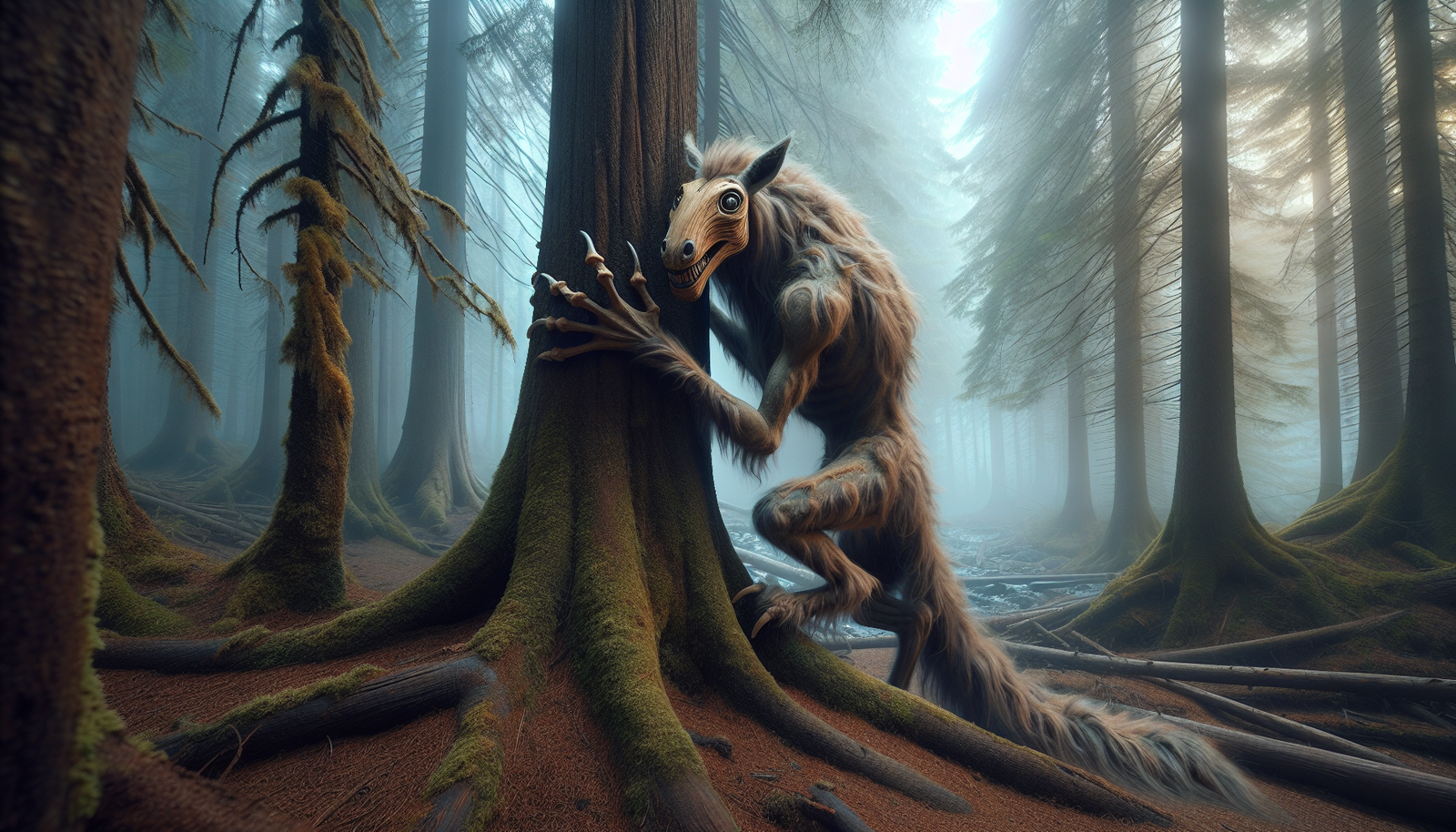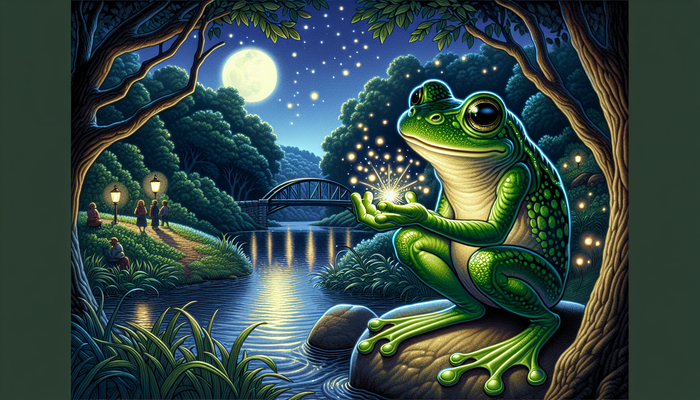New Hampshire Cryptids: From Wood Devils to Lake Monsters

By Dr. Elizabeth Harper, Cryptozoologist and Biologist
New Hampshire, a state known for its picturesque landscapes and rich history, harbors a lesser-known facet that has captivated the imaginations of locals and visitors alike for generations: its cryptozoological curiosities. The dense forests, rugged mountains, and deep lakes that define the Granite State's natural beauty also serve as the backdrop for a myriad of mysterious creatures said to roam the wilderness. From the elusive Wood Devils of Coos County to the sinister aquatic monsters allegedly lurking in the depths of lakes like Dublin Pond, New Hampshire's legendary cryptids have become an integral part of the state's folklore and identity.
As a biologist and historian specializing in North American wildlife and cryptozoology, I have long been fascinated by the enduring allure of these enigmatic beings. Over the years, I have delved deep into historical accounts, eyewitness testimonies, and scientific data, seeking to unravel the mysteries surrounding New Hampshire's most iconic cryptids. Join me on a journey through the state's cryptozoological landscape as we explore the tales, theories, and cultural significance of these captivating creatures.
The Wood Devils: Elusive Bigfoot-like Creatures of Coos County
Among New Hampshire's most renowned cryptids are the Wood Devils, also known as Devil Monkeys, said to inhabit the remote wilderness of Coos County, the state's northernmost and most heavily forested region. Sightings of these tall, thin, hairy bipedal creatures date back to at least the 1930s, with reports describing them as standing 7-9 feet tall and covered in shaggy tan, gray, or brown hair.
What sets the Wood Devils apart from their more famous cryptid cousin, Bigfoot, is their unique physical characteristics and behavior. While Bigfoot is typically portrayed as a hulking, barrel-chested creature, the Wood Devils are known for their slim, gangly build and incredible stealth. Eyewitnesses claim that these creatures possess an uncanny ability to blend into their forest habitat, hiding motionless against trees or swiftly darting out of sight when detected by humans. Their presence is often betrayed only by the bone-chilling screams that echo through the woods, sending shivers down the spines of those who hear them.
Sightings of the Wood Devils reached a peak in the 1970s, with several notable reports emerging from the region:
- In 1977, a hiker near Dixville Notch claimed to have seen an 8-foot-tall creature with grayish hair running on two legs.
- Another incident in 2000 involved a witness spotting a tall, dark, hairy figure while watching the sunrise near Dummer Pond.
These sightings, along with reports of massive footprints and eerie vocalizations, have fueled speculation about the origins and nature of these elusive creatures.
Some researchers have proposed that the Wood Devils could represent an undiscovered primate species or perhaps a subspecies of Sasquatch uniquely adapted to the New Hampshire wilderness. The creatures' distinctive thin, gangly build and stealthy behavior suggest that they may have evolved to thrive in the dense forests and harsh conditions of the region. However, skeptics argue that the lack of concrete evidence, such as clear photographs, video footage, or physical remains, points to the Wood Devils being more legend than reality.
The historical and cultural context surrounding the Wood Devils adds another layer of intrigue to their mystery. Early settlers and loggers in the region gave these creatures colorful nicknames like "Indian Devil," "Ommeethatsees," and "Skunk Bear," hinting at the fear, awe, and wonder they inspired. The "Indian Devil" moniker is particularly intriguing, as it suggests that tales of the Wood Devils may have roots in pre-colonial Native American folklore, with indigenous tribes possibly having their own stories and beliefs about these mysterious forest dwellers.
As a researcher, I find the consistency in eyewitness descriptions and the longevity of the Wood Devil legend compelling. While the lack of definitive proof leaves room for skepticism, the sheer volume of reports and the striking similarities between accounts cannot be easily dismissed. The remote, vast wilderness of Coos County certainly provides ample habitat for an undiscovered species to remain hidden, and the idea of a creature so perfectly adapted to its environment is both fascinating and plausible from a biological standpoint.
The Devil Monkeys: Aggressive Primate-like Cryptids
Alongside the Wood Devils, New Hampshire is also home to reports of another cryptid primate: the Devil Monkeys. These smaller, more aggressive creatures have been sighted not only in the Granite State but throughout New England, adding to the region's rich tapestry of cryptozoological lore.
Described as standing between 3 and 8 feet tall, Devil Monkeys are often compared to baboons or chimpanzees in appearance. They are said to be covered in hair and possess powerful legs that allow them to make impressive leaps and bounds, quickly vanishing from sight when encountered. One of their most distinctive features is the presence of only three toes on each foot, a characteristic that sets them apart from known primate species.
In contrast to the shy and elusive Wood Devils, Devil Monkeys have a more fearsome reputation. Eyewitnesses have reported these creatures raiding livestock, suggesting a more opportunistic and bold nature. Their presence is often accompanied by frightening shrieks and howls that pierce the night, further adding to their menacing aura.
One of the most notable Devil Monkey incidents in New Hampshire occurred in the small town of Danville in 2001. Over the course of two unnerving weeks, multiple residents reported sightings of a chimpanzee-sized creature with reddish-brown fur and a "dog-like face" roaming the area. Attempts to capture the beast proved futile, and just as suddenly as it appeared, the creature vanished, leaving the community puzzled and on edge.
The Danville incident raises intriguing questions about the origins of these mysterious primates. Some speculate that Devil Monkeys could be escapees from zoos or private exotic pet collections, their unusual appearance and behavior the result of generations of captivity and potential hybridization. Others propose that they may be relict populations of presumed-extinct primates, clinging to survival in the remote corners of New England's forests.
As a biologist, I find the idea of an undocumented primate species in the region both exciting and challenging. While the lack of physical evidence makes it difficult to confirm the existence of Devil Monkeys, the consistency in eyewitness descriptions and the recurring reports of sightings suggest that there may be more to these tales than mere folklore or misidentification. The possibility of a previously unknown primate adapted to the New England ecosystem is a tantalizing prospect that merits further investigation.
Aquatic Cryptids: Monsters Lurking in New Hampshire's Lakes and Rivers
New Hampshire's cryptozoological mysteries extend beyond the forests and into the depths of its numerous lakes and rivers. Among the most intriguing of these aquatic enigmas is the Dublin Lake Monster, said to inhabit the murky waters of Dublin Pond in the southwestern part of the state.
Descriptions of the Dublin Lake Monster vary, with some accounts portraying it as a massive eel-like creature, while others depict it as a strange serpentine "water horse." The most chilling tales surrounding this cryptid involve traumatized divers encountering monstrous beings in underwater caves or air-filled caverns deep beneath the lake's surface.
One particularly unnerving legend tells of a diver who went missing in Dublin Pond for days, only to emerge naked and incoherent on the shore, babbling about terrifying creatures lurking in the depths. Another version of the story has the diver ranting about beings inhabiting subterranean lairs, hinting at a world of unknown horrors hidden beneath the tranquil surface of the lake.
While these tales are undoubtedly more legend than fact, they have firmly established Dublin Pond as a hotspot for cryptozoological intrigue in the state. The idea of an undiscovered aquatic species or even a remnant population of prehistoric creatures surviving in the lake's depths is a captivating notion that has fueled the imaginations of locals and visitors for generations.
As a researcher, I approach these aquatic cryptid legends with a mix of fascination and skepticism. The lack of concrete evidence, such as clear photographs or video footage of the alleged creatures, makes it difficult to substantiate the claims. However, the consistency in eyewitness descriptions and the enduring nature of these tales suggest that there may be more to the story than mere folklore or misidentification.
From a biological perspective, the presence of undocumented aquatic species in New Hampshire's lakes and rivers is not entirely implausible. The state's waterways are home to a diverse array of fish, amphibians, and invertebrates, some of which may have yet to be formally identified or studied. The idea of a large, eel-like creature or a serpentine "water horse" adapted to the unique conditions of Dublin Pond is an intriguing possibility that warrants further investigation.
Out-of-Place Animals and Other Cryptozoological Oddities
In addition to the Wood Devils, Devil Monkeys, and aquatic cryptids, New Hampshire has its fair share of reports involving out-of-place animals and other cryptozoological oddities. These sightings add to the state's rich tapestry of mysterious creatures and further fuel the imaginations of those who believe in the existence of undocumented species.
One such category of out-of-place animals is the persistent reports of mountain lions, also known as catamounts or cougars, in the state. Despite being officially considered extinct in the Northeast, sightings of these large, elusive felines continue to surface across New England, including New Hampshire. A notable example is the 2003 Barnstead sighting, where a witness claimed to have spotted a mountain lion in the area.
The possibility of a remnant population of mountain lions surviving in the state's remote wilderness is an intriguing prospect. As a biologist, I recognize that the vast, uncharted territories of New Hampshire could potentially harbor small, isolated populations of these felines, their presence going largely undetected due to their secretive nature and the challenges of conducting comprehensive surveys in rugged, densely forested areas.
Another cryptozoological oddity that has captured the attention of researchers and enthusiasts alike is the sporadic reports of non-native primates in New Hampshire's wilderness. One such incident occurred in 2009 when a witness claimed to have seen a "monkey" near the town of Newport, describing the creature as standing 3-4 feet tall with reddish fur.
These sightings raise questions about the origins of these out-of-place primates. Could they be escapees from private exotic pet collections or even clandestine research facilities? Or might they be connected to the larger mystery of the Devil Monkeys, their presence in the state hinting at a more widespread phenomenon?
As a researcher, I approach these reports with a mix of curiosity and caution. While the idea of undocumented primate species roaming the New Hampshire wilderness is undeniably fascinating, the lack of concrete evidence makes it difficult to draw definitive conclusions. Misidentification, hoaxes, and the power of suggestion may play a role in some of these sightings, underscoring the need for rigorous investigation and a critical evaluation of the available data.
Beyond the realm of cryptid creatures, New Hampshire also boasts a rich tradition of UFO lore and alien encounters. Perhaps the most famous of these is the Betty and Barney Hill incident of 1961, widely considered to be the first widely publicized alien abduction report in history.
The Hills, a married couple from Portsmouth, claimed to have been pursued by a flying saucer while driving through the White Mountains late one night. Under hypnosis, they recalled being taken aboard the craft and subjected to bizarre medical examinations by grey-skinned entities. Their story set the template for countless subsequent alien abduction accounts and left an indelible mark on New Hampshire's paranormal landscape.
While the veracity of the Hills' experience remains a topic of debate, their story has undeniably shaped the public perception of extraterrestrial encounters and has become an integral part of New Hampshire's cryptozoological lore. As a researcher, I find the Hills' case to be a fascinating example of how extraordinary claims can capture the public imagination and inspire generations of investigators and enthusiasts to explore the boundaries of the unknown.
The Enduring Allure of New Hampshire's Cryptid Legends
New Hampshire's cryptid legends have long been a source of fascination, debate, and inspiration for those who seek to unravel the mysteries of the natural world. From the elusive Wood Devils to the sinister aquatic monsters said to inhabit the state's lakes and rivers, these creatures have captured the imaginations of generations and have become an integral part of the state's cultural identity.
For skeptics, the lack of concrete evidence and the reliance on eyewitness testimony are often cited as reasons to dismiss the existence of these cryptids. They argue that misidentification, hoaxes, and the power of suggestion can account for many of the reported sightings, and that extraordinary claims require extraordinary evidence to be taken seriously.
Believers, on the other hand, point to the vast, uncharted wilderness of New Hampshire as a potential haven for undiscovered species or relict populations of presumed-extinct creatures. They argue that the consistency in eyewitness descriptions and the longevity of these legends suggest that there may be more to these tales than mere folklore or overactive imaginations.
As a researcher, I find myself navigating the space between skepticism and open-minded curiosity. While I recognize the need for rigorous scientific investigation and a critical evaluation of the available evidence, I also believe that the enduring allure of these cryptid legends speaks to something deeper in the human psyche.
Perhaps it is our innate fascination with the unknown, our desire to explore the boundaries of the possible, or our longing for a world that still holds mysteries waiting to be uncovered. In an age where technology has made the world feel increasingly mapped and catalogued, cryptids like the Wood Devils and lake monsters serve as reminders that there may yet be wonders lurking in the shadows, just beyond the reach of our understanding.
This enduring fascination has given rise to a vibrant culture surrounding New Hampshire's cryptid legends. Local festivals, such as Danville's annual "Devil Monkey Day," celebrate these mysterious creatures and the stories that have grown up around them. Artists, writers, and craftspeople have drawn inspiration from the state's rich cryptozoological lore, creating works that capture the imagination and keep these legends alive for future generations.
In recent years, modern approaches to investigating cryptid sightings have emerged, offering new tools and techniques for researchers seeking to unravel these mysteries. Trail cameras, drone surveys, and environmental DNA (eDNA) sampling of lakes and rivers provide opportunities to gather data and potentially shed light on the existence of undocumented species.
However, even as the quest for definitive evidence continues, it is important to recognize the cultural and psychological significance of these legends. Whether or not the Wood Devils, Devil Monkeys, or lake monsters are ever proven to exist, their stories have become a part of New Hampshire's identity, a testament to the enduring power of mystery and the human imagination.
From Bigfoot to UFOs: Hangar 1 Publishing Has You Covered!
Explore Untold Stories: Venture into the world of UFOs, cryptids, Bigfoot, and beyond. Every story is a journey into the extraordinary.
Immersive Book Technology: Experience real videos, sights, and sounds within our books. Its not just reading; its an adventure.



























